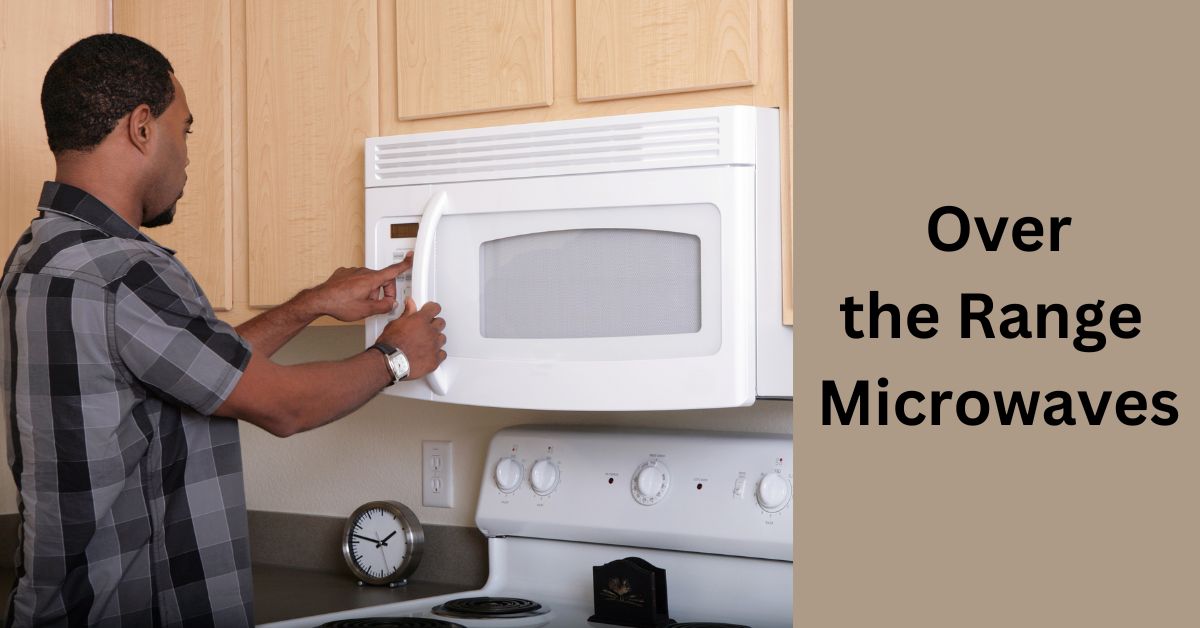Table of Contents
Note: If you came to this post on over-the-range microwave ovens through a random search, please click on this parent page and our home page for more context.
Over-the-Range Microwaves
Before we get into the details of over-the-range microwave ovens, you might want to start with our general post on microwave ovens. This lays out a comparison of the various types of microwaves.
- Related post: Microwave Ovens
- Related post: Kitchen Layout
What to Look for In an Over-the-Range Microwave
Venting Capability
Venting is an important consideration in choosing an over-the-range microwave. It has to provide venting for the range or cooktop below.
Over-the-range microwaves are typically set up for venting in one of two ways:
- Recirculation venting only
- Recirculation venting with an optional external roof/wall venting capability
The one you choose will depend on the layout of your kitchen and whether it is set up for external venting.
Selecting the venting mode (recirculation, roof venting, or wall venting) is just a matter of rotating the blower motor to suit.
So, replacing an over-the-range microwave that already vents to the exterior is relatively simple. This is because the ventilation ductwork is already in place.
But, If you do not have existing ventilation ductwork, installing it can be an expensive and disruptive project. In this case, you are probably better off with a recirculating vent microwave.
Most over-the-range microwaves are preset to vent internally.
Microwave Power
The cooking power of an over-the-range microwave is expressed in watts. The benchmark for microwave power is generally considered to be 1,000 watts. Lower wattage equates to longer cooking times.
Inverter Technology
Some microwaves utilize inverter technology to smooth out the delivery of power at lower power settings.
Microwave Size
The size of a microwave is the capacity of its cooking cavity. Most over-the-range microwaves are in the 1.5 to 2.0 cubic feet range.
Microwave Settings
Preprogrammed settings take the guesswork out of common microwave cooking tasks. These are popcorn, defrosting, softening, melting, adding a minute, etc.
Sensor Cooking
Sensors measure the steam given off by the food in the microwave cavity. It will match cooking times and power to the type of food selected. This prevents over-cooking.
Easily Read Displays
Some over-the-range microwaves have their control panels at the bottom rather than the side. This makes them easier to read, especially for short people.
Lighting
Many over-the-range microwaves have lighting features. These will provide task lighting for the range.
Convection Cooking
Some over-the-range microwaves have a convection cooking capability. Those that do generally need less microwave power.
How High Up Should the Over-the-Range Microwave Be?
Most local building codes, which generally follow the International Residential Code (IRC), require a 30-inch clearance between the top of a range and any combustible surface.
However, they generally allow over-the-range microwaves, which are much less combustible than, say, a wooden cabinet, to be installed per their manufacturer’s instructions.
Another authority, the National Kitchen and Bath Association, says that the bottom of the over-the-range microwave should be no higher than 54 inches above the floor. This would provide a clearance of 18 inches between the microwave and the cooktop, which is typically 36 inches above the floor.
However, we would advise in all cases following the manufacturer’s recommendations, since there may be warranty issues.
What Size Are Over-the-Range Microwave Cabinets?
These are important dimensions. Because the over-the-range microwave is suspended from the cabinet above it as well as secured to the wall behind it.
The standard size for a cabinet in an over-the-range microwave application is 30” wide, 12” or 15” high, and 12” deep. The standard over-the-range microwave is designed to work with these dimensions but you need to double-check your own situation.
A particularly important dimension is cabinet depth. The typical depth of an over-the-range microwave is 15” to 16” meaning that the front of the microwave will be proud of the face of the cabinet. So you want to be sure that the holes for the top mounting points of the microwave are well within the 12” depth of the cabinet.
What Are the Power Requirements?
Almost all over-the-range microwaves require the installation of a 120-volt power outlet in the cabinet above. It should be on a dedicated 20-amp circuit.
How to Maintain Over-the-Range Microwaves?
All over-the-range microwaves require the periodic cleaning of their grease filter. This is simply removed, washed in your kitchen sink, and replaced. If it is exceptionally dirty, put it in a pan with water and bring it to a boil. Add dish detergent and a half cup of baking soda.
If you have a microwave that recirculates air through a carbon filter, you will need to change the filter from time to time.
Pros and Cons of Over-the-Range Microwave Ovens
But wait! An over-the-range microwave might not be a good idea for you anyway. Let’s look at the pros and cons.
Pros of Over-the-Range Microwave Ovens
- The over-the-range microwave saves about 4 sq ft of precious space by moving your microwave off the kitchen counter, where it occupies a valuable prep or other use area. This is especially important in a small kitchen.
- It doubles as a range hood and extracts steam, smoke, and food odors. This two-in-one feature is a money saver.
- It puts the microwave out of reach of young children.
- Built-in task lighting makes it easier to see what is going on with your range-top cooking.
Cons of Over-the-Range Microwave Ovens
- Short people and people with low upper body strength find them difficult, dangerous, or even impossible to use. In fact, it’s not a good idea for anyone to be lifting anything hot or heavy above shoulder height.
- It is certainly hazardous to use an over-the-range microwave if you have something cooking on the range top.
- It’s hard to see what is going on in the microwave.
- Most over-the-range microwaves are ductless and only recirculate the air within the kitchen through a charcoal filter. They have a limited air handling capacity of around 300 cfm (cubic feet per minute). A top-of-the-line over-the-range microwave will have both interior and exterior ventilation/extraction options.
- If you have a high BTU gas range, you are better off with a dedicated range hood than an over-the-range microwave.
In our opinion and leaning into the Universal Design emphasis in this Guide, the safety cons outweigh the benefits and we do not recommend the over-the-range microwave.
- Related post: Kitchens for the Elderly
- Related post: Range Hoods
Over-the-Range Microwaves on Amazon
test
- Related post: Drawer Microwave Ovens
- Related post: Countertop Microwave Ovens
- Related post: Built-In Microwave Ovens






Leave a Reply